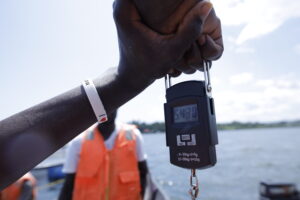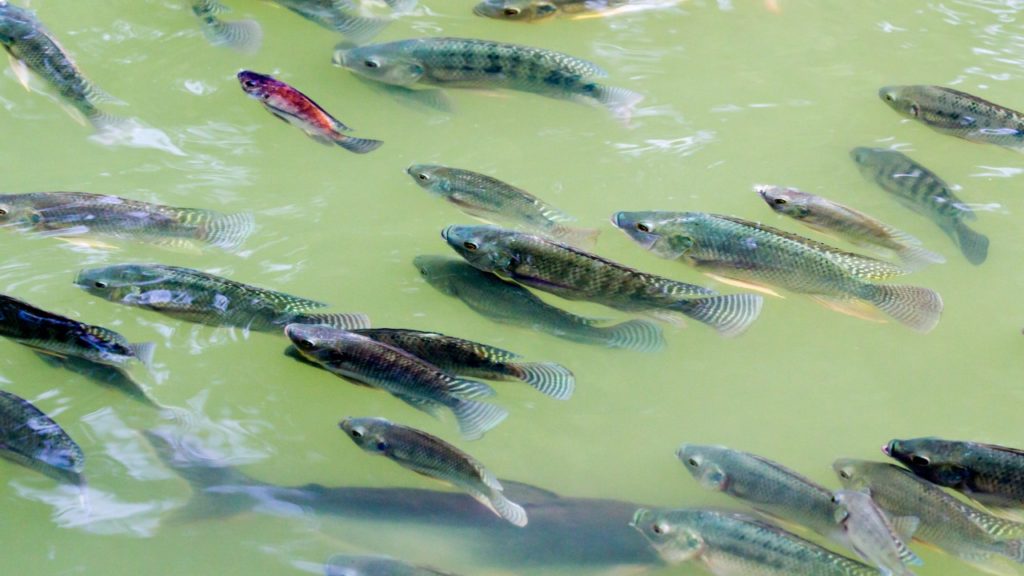
The aquaculture industry is an expanding frontier, not just globally but specifically in East Africa. Whether you’re a young graduate with a dream of contributing to sustainable food solutions, or a working adult contemplating diversification of your investment portfolio, fish farming could be an exciting venture for you. This blog serves as a quick guide focusing on two leading species in East Africa—tilapia and catfish. From market insights to setup logistics to expert tips, this roadmap aims to give you a quick guide to help you on your way to your future in aquaculture.
Why Choose Fish Farming?
Nutritional Importance
It is no secret that fish is not only a delicious dish, but also a vital source of nutrition. In fact, fish provides us with essential proteins, omega-3 fatty acids, and vital minerals such as zinc and iodine, making it a true nutritional powerhouse. Two types of fish that stand out in terms of their nutrient profile are tilapia and catfish. Not only are these fish easy to prepare for household consumption, but they also play a significant role in addressing malnutrition and food security issues because of their nutrient richness and affordability. With their well-balanced nutritional profile, tilapia and catfish are an excellent addition to any healthy diet.
Economic Importance
Fish farming is not only beneficial in terms of nutrition but also a thriving industry that can bring in significant financial gains for farm owners, workers and the community as a whole. The global aquaculture market is worth billions of dollars so investing in farming can prove to be a wise decision. The profit margins for tilapia and catfish farming in East Africa are quite promising. In Kenya, fish cage production in Lake Victoria is profitable with an average gross margin of KSH 1146,727.68 (USD 10,545.59) and net farm income of KSH 1020,518.78 (USD 9384.94) in a production cycle (Obeiro et al,. 2022) This depends on various factors such as operational expenses including feed and labor costs, as well as the sales price.
How to start a fish farm
Starting a fish farm can happen pretty fast, but if you want it to be a successful business, you need to take your time and get all the details right. Think of it like walking on two legs: one leg is knowing how to raise fish well (that’s the aquaculture part), and the other leg is knowing how to run a good business. You need both to stand strong in the fish farming world.
| Step | Production | Business |
| Planning | Farm planning: Species Location Type of culture system |
Business planning: Orientation Define your Idea Research Business planning |
| Start up | Secure location Secure permits & licenses Set up infrastructure |
Legal compliance Financial management Human resource management Logistics Marketing & sales |
| Operation | Water quality Stocking Feeding Monitoring Harvest |
Business planning phases
1. Orientation
When you think you might be interested in starting a fish farm the first thing to do is to gather more information. Maybe not yet a full scale market research, but definitely a thorough orientation. After all, when you start a business you don’t just want to make sure that a fish farm can make money. You also want to make sure that it is the right venture for you; that you will enjoy it and will be able to run the business in the context of your life. As such we highly recommend you talk to and visit other fish farmers. How did they get started, how are they faring? Also associations and other key sector players can give you interesting information to give you a better understanding of the realities of fish farming in practice. If after this you still fancy a life as a fish farmer, then the next step is to firm up your idea.
2. Define your idea
So by now you think that you have what it takes to set up and operate a successful fish farm. Before you go any further and turn the entire internet, and your network upside down to learn every single thing about every possible fish farm set up, it is helpful to narrow down to what you have in mind. For example, what is your starting point? Do you want to start a profitable fish farm in any location, or do you have land available and want to locate the farm there? Are you leaning towards Tilapia or Catfish? Do you want to do ponds or cages? Do you want a big farm or do you want a smaller scale farm? Do you want to run it yourself, or do you plan to hire a farm manager? All these are fundamental questions to ask yourself. These answers will give you the rough outline of your farm.
3. Research
For a more detailed understanding of the market dynamics of fish, as well as what it takes to start and operate your fish farm successfully, in-depth research is key. The point of doing research is to learn more and to test your assumptions, to see if what you think is true is actually true. Research is often done as a very theoretical exercise. However it can also be done practically and serve more as a road map to guide you to the detailed plan for your successful farm. Below is a table to help you understand the difference between a theoretical and a practical approach to research.
| Research area | Theoretical | Practical |
|---|---|---|
| Water parameters | the ideal water temperature for Tilapia is from 28-32oC | The temperature of my pond water is 29oC. Therefore the most suitable species to cultivate is Tilapia |
| Location | Average pond dimension for Tilapia growth is 30X25m2. | I can comfortably fit 4 fish ponds of this size + support buildings on my land |
| Fish sales | The average fish price in this location is XX | 5 buyers have told me that they are buying 10mt of 450 gram fish at price X each month |
You can see that practical research does not mean theory is not necessary. It simply goes to the actual source to get real world information, and applies the information to your specific situation and gives you actionable information. For example in the above examples if you were planning to grow Catfish you might want to switch to Tilapia or include water treatment in your budgets, or if you were planning on 10 fish ponds you now know that you can only fit 4 on your plot and you might need to buy more land or switch locations if you really need 10. It is a way to develop and amend the rough draft that you had pictured in your mind, into a fully fledged viable business model.
At this time you also want to identify your potential competition, understand consumer preferences, market prices and legal requirements. Diving in without testing the waters can be risky, so take the time to gather all the necessary information before making any significant investments.
Tip: Do record all the expenses that you are incurring in this stage, because later on when you are starting your business they will be deductible expenses if you have documented them well!
4. Business plan Writing
You have done your research and you are confident that you have a good idea for a successful fish farm that will work for you. What is next? Proper business planning! Whereas previously you were doing research, now it is time to take all that you have learned and write it into a concise and realistic plan on how you will set up and operate your own fish farm as a business. Even if you don’t need to attract external funding, a good business plan format (like this one), will help you think through your business model and identify potential gaps that you need to address.
So what are the key elements you need to include in your fish farm business plan?
-
- Farm description; what kind of farm are you planning to start, where is it and what is your vision for it?
- Legal requirements; which permits and licenses will you need and where will you get them?
- Market research; include customer preferences, sales locations, market prices.
- Sales; how and where do you plan to sell your fish and against what price. Why would people buy from you?
- Production plan; how will you grow your fish? What will it cost?
- Start up plan; how will you set up your farm? What is the timeline?
- Management plan; how will you run your farm as a business?
- Financial plan; investment budget (how much will it take to set up) + operating budget (how much will you need to run the business for the first 12 months and how much money do you expect to make) + funding plan (where will the money come from)
For some more helpful tools have a look here: (download lead magnets)
Business plan format – Financial plan format – Example start-up cost for pond farm and a cage farm
Farm planning
As you go through the different phases of business planning you will also be forced to step by step make key decisions for your farm that guide you towards your farming model.
a) Species Selection
One of the critical choices you’ll make in the planning stage is the selection of species for your farm. This blog focuses on tilapia and catfish, which are among the most popular and economically viable species for aquaculture in East Africa. Both have their own sets of advantages and requirements. Tilapia is hardy, grows quickly, and is well-suited for both cage and pond farming systems. It also has broad consumer acceptance. Catfish, on the other hand, is a bottom-dweller that is generally easier to manage in terms of feeding and health. Your choice of species will significantly influence your farm’s operational strategy, from stocking density to feeding schedules. Therefore, consult with aquaculture experts and do market research to align your species selection with both biological and economic considerations.
b) Choosing the Right Location
Geographical Considerations
Location is more than just a piece of land; it’s the physical foundation of your business. The first step is identifying a site with the right geographical characteristics. You will want to consider water source availability, soil type, and climate conditions. For example, tilapia thrive in warm water, ideally between 27 to 30°C, while catfish are more tolerant of varying water temperatures. The site should also be easily accessible for both procurement of supplies and transportation of the harvested fish to market.
Furthermore, you will want to know the community on and near your location and if they support the development of a fish farm.
Water Quality and Availability
Water is the lifeblood of aquaculture. Before committing to a location, assess the water quality, including its pH levels, hardness, and potential contaminants. In East Africa, regions near freshwater bodies like Lake Victoria or the Nile River are often considered ideal for fish farming due to their water quality and availability. However, always get a water quality test conducted and double-check the water volumes available to confirm suitability.
Regulatory Compliance
Another key consideration is zoning regulations. Ensure that the chosen land complies with local, state, and national zoning laws related to aquaculture. Non-compliance can result in heavy fines or even eviction from the land. Before purchasing or leasing any property, consult with local authorities and inspect any land deeds or restrictions that may apply.
Proximity to Market
The closer you are to your market, the lower your transportation costs. However, prime locations often come with higher land costs. It’s essential to strike a balance between the cost of land and its proximity to the market. Being closer to urban areas might increase land costs but can offer better market access, thus allowing for higher selling prices for your fish.
Environmental Impact Assessment
Before breaking ground, conducting an Environmental Impact Assessment (EIA) is not only advisable but a legal requirement. An EIA can help you identify any potential environmental risks associated with your fish farming activity, allowing you to take preventive measures.
Visit Multiple Locations
Don’t settle for the first location that seems to meet your criteria. Visit multiple sites, and weigh the pros and cons of each. Talk to local authorities and fish farming experts to gain insights that might not be immediately obvious. Your choice of location could very well be the make-or-break factor in the success of your venture.
Types of Fish Farming Systems
1. Cage Farming System
Cage fish farming is a sustainable type of aquaculture that involves growing fish in existing water resources. The method involves enclosing fish in a net cage made of wire or fiber netting that is suspended from a floating frame. These cages come in a range of sizes, from 1 to 2000 m3 and more, and can be square or round. The mesh enclosure helps to retain the fish, making it easier to feed, observe, and harvest them. There are various types of cage designs used for farming fish, including fixed cages, floating cages, submersible cages, and submerged cages.
| Pros | Cons |
|---|---|
| – Easier harvesting | – Requires regular feeding since fish cannot acquire their food naturally |
| – It does not require vast chunks of land | – Requires a high level of expertise in constructing cages and proper fish health management |
| – Larger harvests since it supports higher stocking density of fish | – Higher risk of disease |
| – Access to clean water which means less worries about water quality management | – Theft of fish |
2. Pond Farming System
Pond farming is one of the most traditional and widely used methods of aquaculture. It involves digging ponds on your land and stocking them with fish. These ponds can range in size from small backyard setups to large commercial operations.
| Pros | Cons |
|---|---|
| Requires less capital investment compared to cage farm | Requires large land area |
| Low operating cost | Does not support high stocking density as cage fish farm |
| Effluent can be reused in aquaculture or for irrigation in agriculture | Requires expert design and construction |
| Can be built and repaired with locally available materials | Theft of fish |
| It is more flexible: can be built near almost any body of water | Not ideal for any type of terrain |
3. Tank Farming System
This method of fish farming involves raising fish in semi-closed or closed systems. Most of these systems operate by recycling water, thus presenting an efficient and sustainable alternative for fish farming unlike traditional ponds and cage farming. By avoiding the need for constantly changing water, tank fish farming is not only cost-effective but also environmentally friendly. This approach to fish farming is gaining popularity as it provides a reliable and controlled environment for the growth and development of fish.
| Pros | Cons |
|---|---|
| Allows for higher stocking densities of fish | High energy costs; runs on pumps, filters and aerators which increases operational costs |
| Year-round production regardless of seasonal and weather changes | Technical expertise. Requires high level of knowledge and skills to manage |
| Feeding and harvesting operations require less labor and time | High initial investment |
| Produces high-quality fish which often commands premium prices on market | In case of any disease outbreak, it may be disastrous |
Decision-making Factors
Choosing between cage or pond or tank farming systems isn’t always straightforward. It often depends on various factors such as available resources, target production scale, and species-specific requirements. You’ll also need to consider market access, as each system has its own set of logistical considerations for getting your fish to market efficiently. Do not hesitate to contact an expert for advice on what will work best for your situation.
Essential Tools and Equipment
A well-equipped fish farm relies on various tools and equipment to maintain smooth operations. The basic toolkit should include water quality testing kits for monitoring parameters like pH, oxygen level, and temperature. Nets of various sizes are crucial for handling fish, whether it’s for sorting or harvesting. Aerators and oxygen pumps help maintain optimal water conditions, and tools to facilitate efficient feeding. Other must-haves include fish grading equipment for sorting fish by size, hand tools for minor repairs, and safety gear like waterproof boots and gloves for staff. The availability of these tools and equipment ensures that you can address most operational needs in a timely manner, contributing to the success of your fish farm.
For a comprehensive list of tools and equipment you may consider >> click here <<
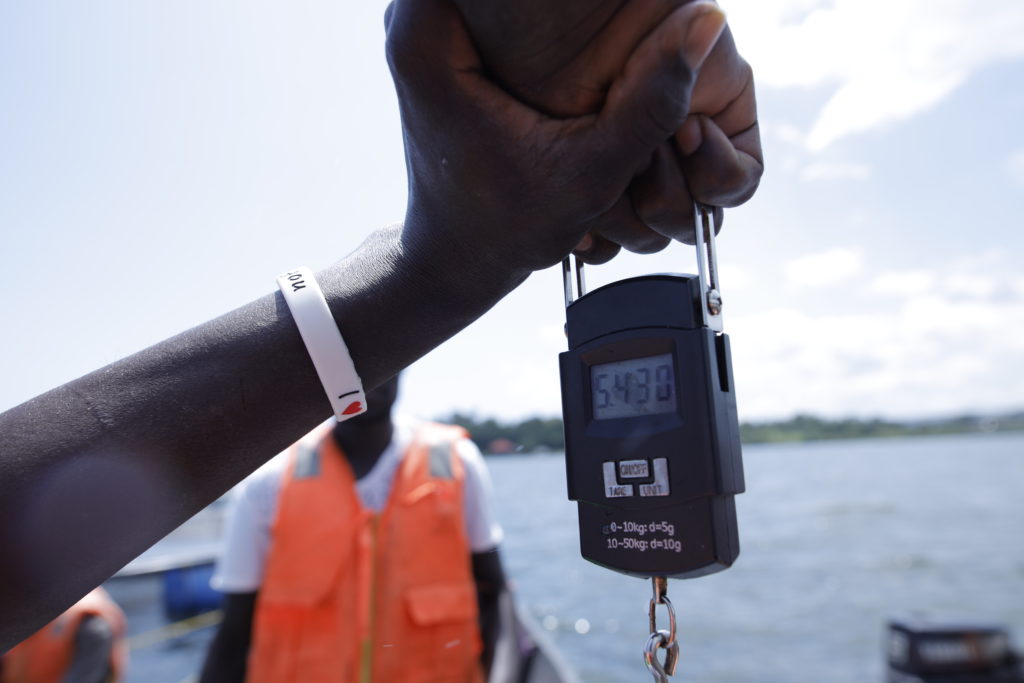
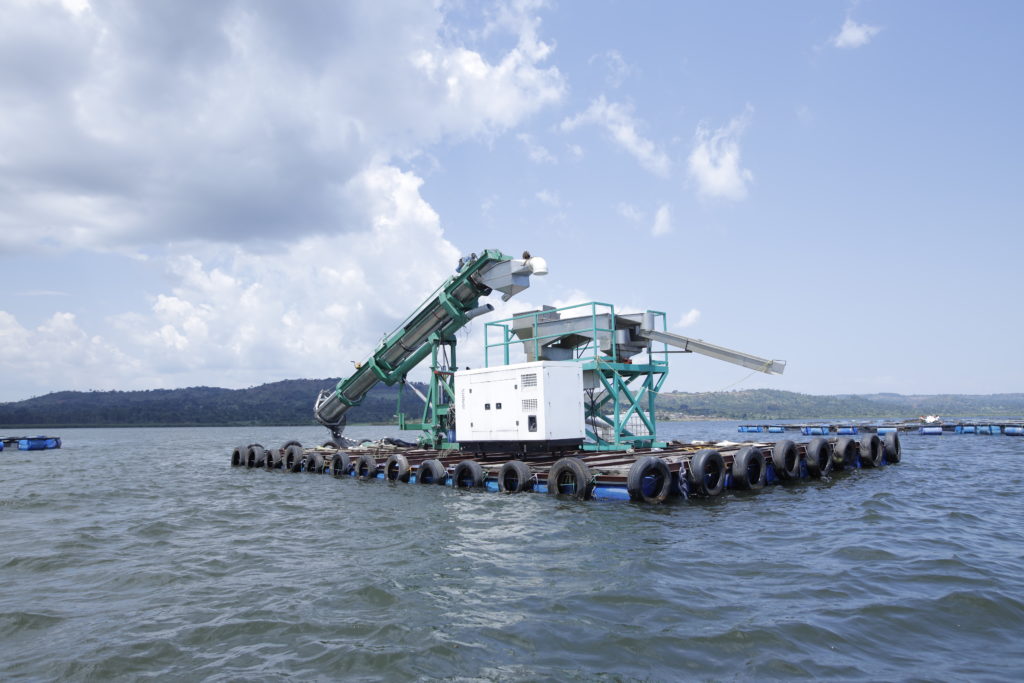
Weighing scale and harvesting machine
Setting Up the Farm
i) Initial Preparations
Before you start digging or placing cages, ensure that you have a good plan for where you want to place your facilities and production units. Furthermore, ensure that you have all the necessary permits and approvals in hand. Legal due diligence can save you from costly complications down the line. Consult a legal advisor familiar with aquaculture regulations to guide you through the process.
ii) Construction and Installation
For Cage Farming
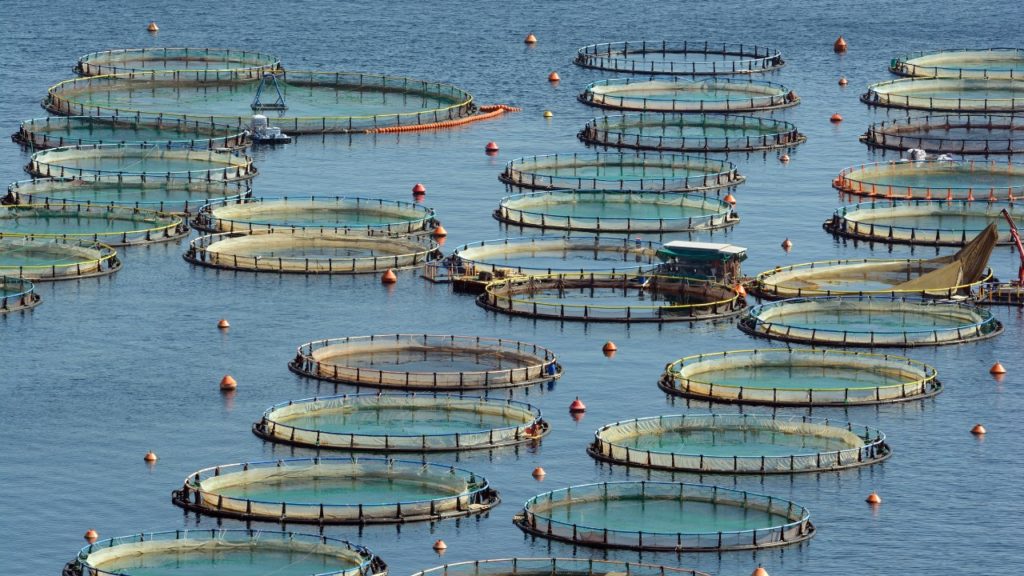
- Material Procurement: High-quality nets, ropes, and buoys are crucial. Opt for UV-resistant materials to ensure durability. Local suppliers are often a reliable source for these materials.
- Cage Assembly: Assembly instructions vary based on the cage type and design. It is advisable to consult experts or even contract an experienced team for the first setup.
- Placement: Position the cages in the water body ensuring they are well-anchored. Depth, current speed, and proximity to the shore are key considerations.
- Safety Measures: Install predator nets and have regular monitoring to check for any signs of wear and tear or other potential hazards.
For Pond Farming
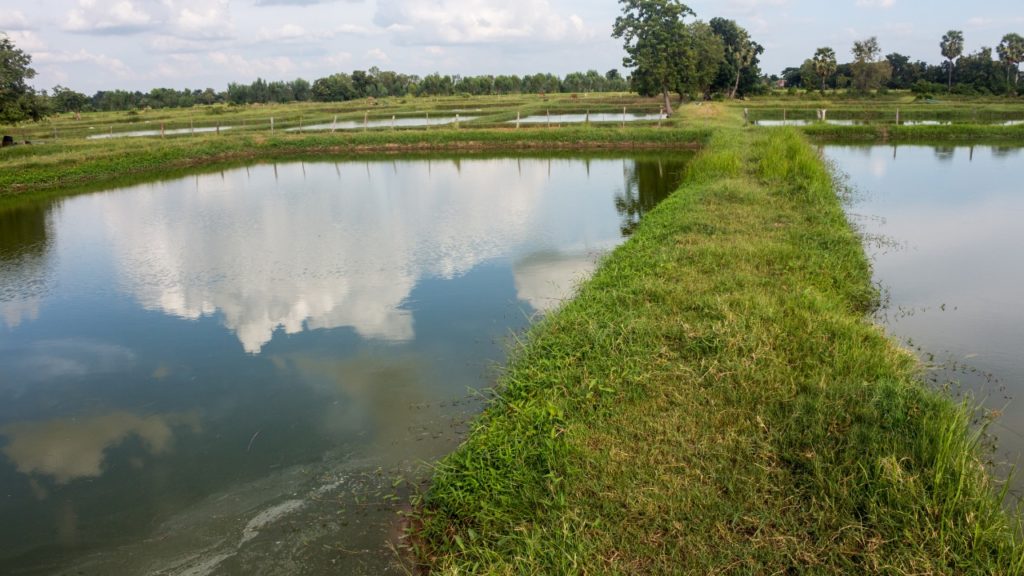
- Land Preparation: The land should be cleared, leveled, and then trenches should be dug for water inflow and outflow. You might need to line the pond with a suitable material to prevent water seepage.
- Water Source: Establish a reliable water source and set up any necessary filtration or treatment facilities.
- Aeration Systems: Install aeration systems to maintain adequate oxygen levels in the water, essential for the healthy growth of both tilapia and catfish.
iii) Supporting Structures and Infrastructure
Alongside your production units (the cages or ponds), an effective fish farm also requires a variety of supporting structures for streamlined operations and long-term success. Here’s a list of spaces that you can consider including in your farm setup.
Road
If your farm is in a remote area you might want to work on the road in order to ensure people, supplies, and equipment can easily reach your farm in all weather conditions.
Office Space
An administrative hub where you can handle paperwork, conduct meetings, and perhaps even have a small lab for water testing. It should be equipped with essentials like computers, internet, and a filing system.
Mechanical Workshop
A dedicated space for the maintenance and repair of critical farm equipment like aerators, pumps, and nets. The workshop should be stocked with essential tools and spare parts.
Feed stores
To store bulk feed in a clean, dry, and well-ventilated space. Proper storage helps prevent spoilage and maintain the nutritional value of the feed. Ensure that your stores are secure since most likely the feed, aside from the fish, will be one of the most valuable assets on your farm.
Quarantine Tanks
An isolated area where new fish can be kept for observation before being introduced into the main farming system. This helps to prevent the spread of disease.
Waste Management System
A system to effectively manage fish waste and other byproducts, either for disposal or potential re-use as fertilizers.
Security Post
A structure at the entrance or around the perimeter where security staff can monitor and control access to the farm. This is crucial to ensure both the safety of your investment and your fish stock.
Staff Amenities
Provisions for staff like a break room, washrooms, and perhaps even lodging if your farm is in a remote location.
Cold Storage
If your farm is large or you plan to store harvested fish for any period, a cold storage unit may be necessary to keep your product fresh until it reaches the market.
Sanitation stations
To minimize the threat of contamination being brought into the farm, sanitation stations are typically placed at all entry and exit points; these stations usually have footbaths, hand sanitizers, and other disinfectants.
By thoughtfully incorporating these supporting structures, you enhance the efficiency, sustainability, and overall viability of your fish farm.
iv) Stocking the Farm
Fingerlings
Purchase quality fingerlings from reputable suppliers. For tilapia and catfish, you can often source fingerlings locally in East Africa, but ensure they come from certified hatcheries to guarantee health and genetic quality.
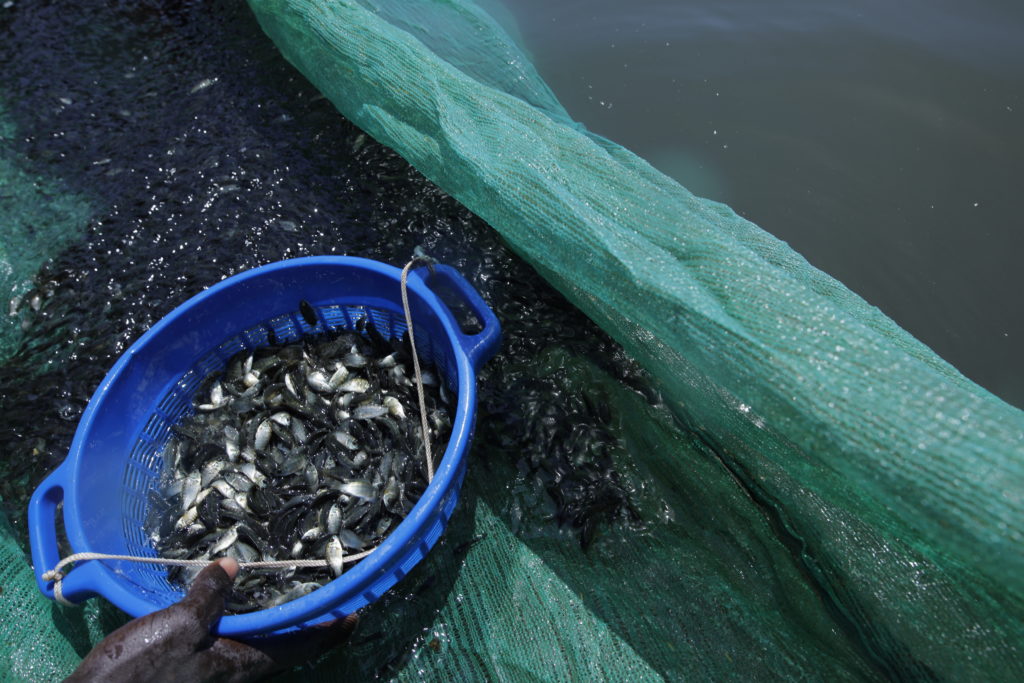
Sorting of tilapia fingerlings
Stocking Density
Tilapia and catfish have different stocking density requirements. For tilapia, you can stock up to 60-100 fish per cubic meter in cages and 4-6 fish per square meter in ponds. For catfish, the density can be slightly lower due to their size and behavioral traits.
v) Feed
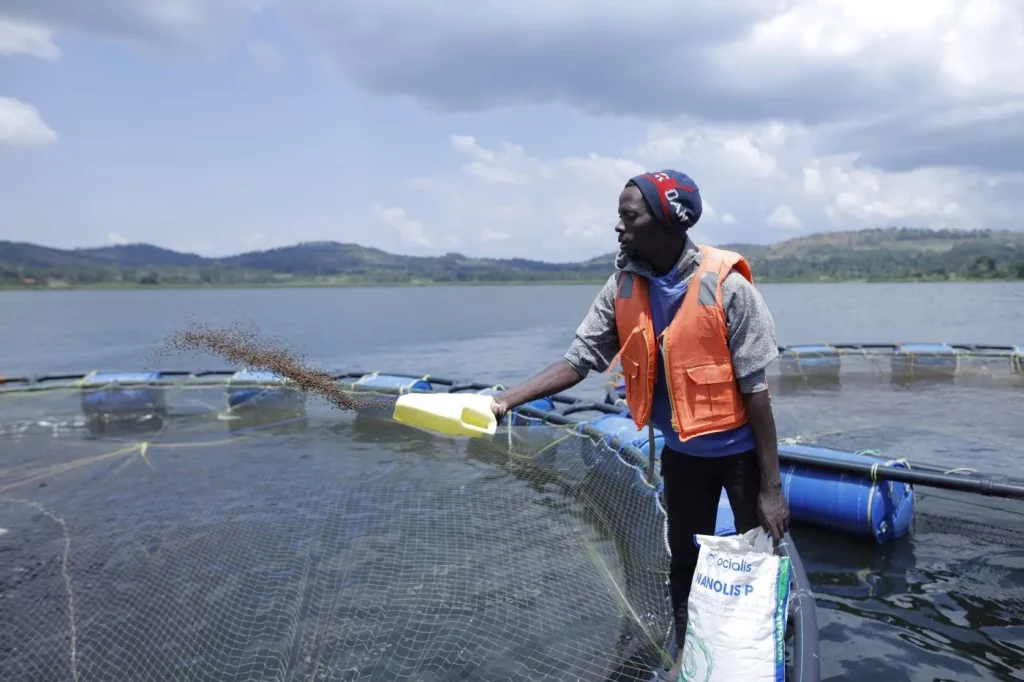
Both tilapia and catfish are relatively easy to feed, accepting a wide range of commercial feeds. However, nutritional requirements differ between the species, so consult aquaculture nutritionists to formulate an ideal feeding schedule. By planning ahead and by having several sources of feed already selected you will be able to source the required feed easily, and you will be able to plan your finances accordingly.
vi) Management and monitoring systems
Routine checks for water quality, fish health, and equipment integrity are a must. Record-keeping is vital for tracking growth rates, feed conversion ratios, and any health issues. Use these records for ongoing improvement and as a database for troubleshooting future challenges. Ensure that you have the right tools and records in place to record these parameters once you start.
Operations and Maintenance
a) Daily Operations
Water Quality monitoring
Daily monitoring of water parameters like temperature, pH, and oxygen levels is crucial. Any fluctuations can lead to stress or disease among the fish, thereby affecting your yield and profitability.
Feeding Schedules
Feed your tilapia and catfish as per the schedule developed in consultation with aquaculture nutritionists. Overfeeding can not only waste resources but also deteriorate water quality.
Inspection
Inspect the physical infrastructure regularly. In cage farming, ensure that the cages are secure and free from wear and tear. In pond farming, check the pond lining, aeration systems, and water inlets and outlets for any issues.
b) Preventive Maintenance
Biosecurity measures
Implement biosecurity measures such as nets or fences to keep out predators and unauthorized persons. Limit access to essential personnel only.
Health Check-ups
Periodic health check-ups for the fish can preempt many potential problems. Signs of stress, abnormal behavior, or noticeable mortality rates should prompt immediate action.
Equipment maintenance
Regular maintenance schedules for aeration systems, feeding mechanisms, and water treatment facilities can prevent unexpected breakdowns and loss of stock.
c) Emergency Protocols
Have protocols in place for emergencies such as power failures, equipment breakdowns, or sudden disease outbreaks. Quick and efficient action can mitigate the impact of these unforeseen events.
d) Harvesting and Post-harvest handling
Timely harvesting is essential for maximizing profitability. Delaying harvest can lead to increased feeding costs and a reduction in meat quality. Once harvested, proper post-harvest handling, like sorting and storing the fish at appropriate temperatures, is crucial for maintaining product quality until it reaches the market.
Marketing and Sales Strategies
As part of your business planning you will have already laid out a strategy for marketing and sales. To learn more about drafting a marketing and sales strategy that works for your farm have a look at our guide: how to sell fish.
Conclusion
Starting a fish farming venture, particularly focused on tilapia and catfish in East Africa, is more than a promising business—it’s a means to contribute to food security and economic growth in the region. By understanding the market, choosing the right farming system, and implementing effective operational and marketing strategies, you set the stage for a rewarding and sustainable business.
Remember, the aquaculture journey is a long-term commitment requiring careful planning, continuous learning, and regular adaptation to market trends and biological challenges. With the right resources and dedication, your fish farm can be both profitable and fulfilling. If you find the prospect daunting or have questions along the way, Planex Aquaculture offers comprehensive support services to guide you through every step of your aquaculture venture. From farm setup to operations and market strategy, our expertise aims to simplify your journey to becoming a successful fish farmer.


